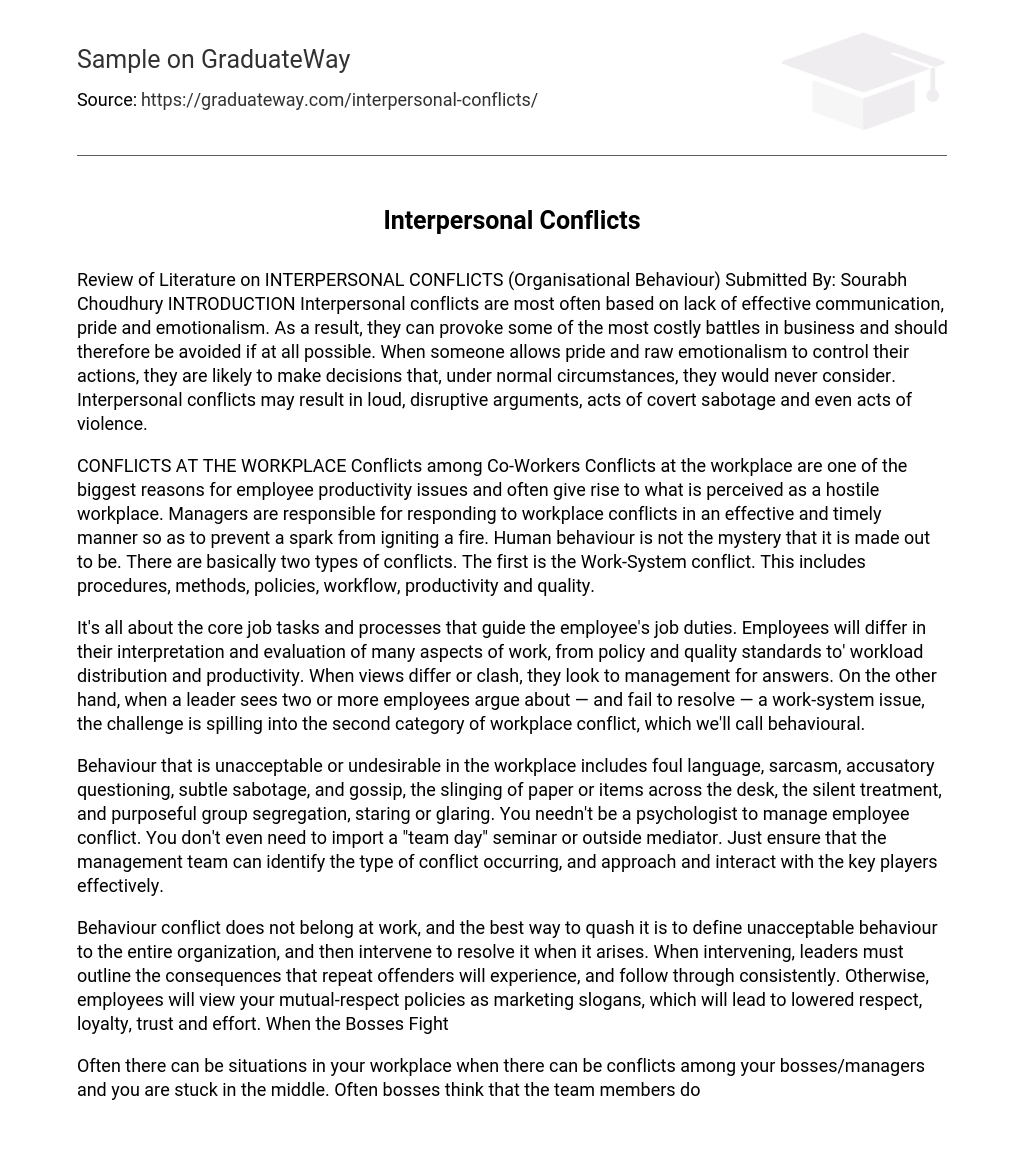INTRODUCTION
Interpersonal conflicts arise from ineffective communication, pride, and emotionalism, frequently leading to expensive battles in business. Thus, if feasible, these conflicts should be avoided. Allowing pride and unchecked emotions to dictate actions may lead individuals to make decisions that they would typically steer clear of. Interpersonal conflicts can manifest as noisy and disruptive arguments, covert acts of sabotage, and even violence.
CONFLICTS AT THE WORKPLACE
Conflicts among Co-Workers in the workplace can significantly affect employee productivity and create a hostile work environment. Managers must promptly and efficiently address these conflicts to prevent them from escalating. Understanding human behavior is not as enigmatic as it may appear. There are two primary conflict types: Work-System conflicts encompassing procedures, methods, policies, workflow, productivity, and quality.
The main focus is on the core job tasks and processes that dictate an employee’s duties. Employees may have different interpretations and assessments of various aspects of their work, including policies, quality standards, workload distribution, and productivity. If there are conflicting views, employees typically seek guidance from management. However, if a leader observes two or more employees arguing over a work-system issue and failing to resolve it, this conflict is categorized as behavioral.
Unacceptable or undesirable behaviors in the workplace encompass foul language, sarcasm, accusatory questioning, subtle sabotage, gossip, slinging of paper or items across the desk, giving the silent treatment, purposeful group segregation, and staring or glaring. Managing employee conflict does not necessarily require a psychologist or external mediation like a “team day” seminar. It simply requires the management team to identify the type of conflict and effectively engage with the key players.
At work, it is important to address and eliminate behaviour conflict. The most effective approach is to establish clear guidelines for unacceptable behaviour that apply to the entire organization and to take action to resolve conflicts as they occur. Leaders must communicate the consequences that repeat offenders will face and consistently enforce these consequences. Failure to do so will result in employees perceiving your mutual-respect policies as mere marketing slogans, which will diminish respect, loyalty, trust, and effort.
Conflicts among bosses/managers in the workplace can often leave employees stuck in the middle. Bosses may think that their team members are unaware or uninterested in the impact of these conflicts on others. Nevertheless, the consequences of such conflicts ultimately affect those lower down in the hierarchy. To tackle these situations, it is essential to directly and clearly communicate any contradictory instructions received from both parties.
If possible, try to involve a higher-up third party in resolving any conflicts and ensure that any agreements or decisions are documented in writing to prevent disagreements among managers. It is important to avoid discussing these issues with co-workers and making personal judgements. Conflicts related to customers and employees require careful consideration and reasoning to find a solution, as they can have a significant impact on an organization’s profitability. Resolving customer issues is not always a straightforward process, and not all vendors may be as cooperative.
You might also encounter an unpleasant customer whom you simply do not wish to assist. However, it is important to remember that customer complaints present a great marketing opportunity. By actively listening and empathizing with customers, and by understanding their underlying interests, conflicts can be resolved or even prevented altogether.
CONFLICT RESOLUTION MECHANISM
The E-R-I model, which represents emotions, reason, and intuition, follows a systematic approach to aid in problem-solving. It also provides tactics that can be applied to various scenarios. Emotions play a crucial role in conflict resolution and must be dealt with initially. This involves managing negative emotions like anger, resentment, mistrust, or fear that may hinder the resolution process, whether they belong to you or others involved. The next step in the E-R-I model is rationality. By employing reasoning techniques, you can gain a deeper understanding of the conflict and identify suitable strategies for resolution.
Conflicts can occur for different reasons, including inadequate communication, lack of information, false assumptions, divergent personality styles, or conflicting interests, needs, and values. Resolving these conflicts requires using intuition. During the intuition phase, new ideas and alternatives are generated to address the conflict. The most suitable approach is then selected intuitively for a specific situation. However, it is crucial to set aside emotions initially, fully understand the situation and consider different conflict resolution methods before relying on intuition.
CONCLUSION
Conflict is inevitable in every aspect of human life. It is present in nations competing against nations, workers against employers, parents against children, and children against siblings. Even sports teams are created to engage in a controlled form of conflict. Throughout history, the poor have consistently fought against the rich. Both electoral and judicial processes inherently involve adversarial elements. In literature, conflict is a fundamental element, whether it is between humans, nature, oneself, or society.
Reference
- “Take Emotion Out of Conflict Resolution”-By Scott, Gini Graham. T+D, Feb2008, Vol. 62 Issue 2, p84-85, 2p,
- “Responsible Relationships” – By Neder, Dennis W.. Personal Excellence, Jan2008, Vol. 13 Issue 1, p6-6, 1/2p
- “GENDER, OCCUPATIONAL CLASS AND WORK-LIFE CONFLICT”-By Lyonette, Clare; Crompton, Rosemary; Wall, Karin. Community, Work & Family, Aug2007, Vol. 10 Issue 3, p283-308, 26p,
- “The Inevitability of Conflict”- By Watson, Scott. Security: For Buyers of Products, Systems & Services, Aug2007, Vol. 44 Issue 8, p32-35, 3p
- “Two People, One Breadwinner”- By Siegel, Deborah. Psychology Today, July/Aug2007, Vol. 40 Issue 4, p46-48, 3p 6. “5 keys to resolving employee conflict” by Hyde, Mark A.. Supervision, Apr2008, Vol. 69 Issue 4, p3-6, 4p 7.
- When Bosses Fight” by Grosdidier, Sheila. Firstline, Apr2008, Vol. 4 Issue 3, p16-21, 5p





